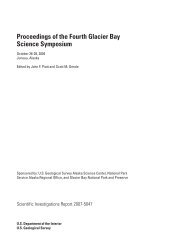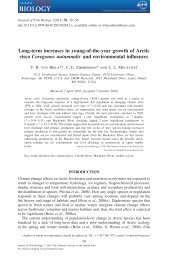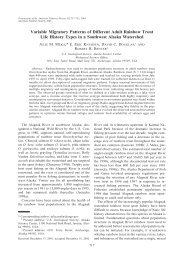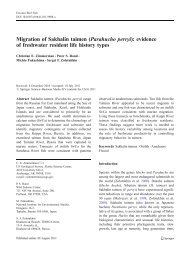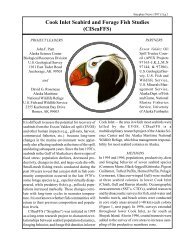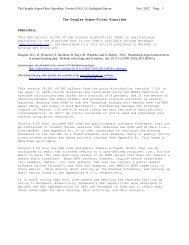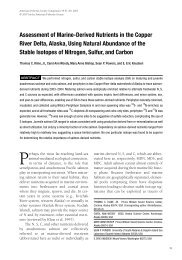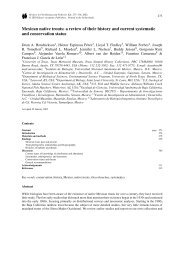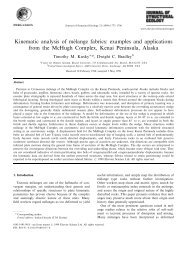UNCORRECTED PAGE PROOFS - USGS Alaska Science Center
UNCORRECTED PAGE PROOFS - USGS Alaska Science Center
UNCORRECTED PAGE PROOFS - USGS Alaska Science Center
You also want an ePaper? Increase the reach of your titles
YUMPU automatically turns print PDFs into web optimized ePapers that Google loves.
spe371-01 page 17 of 31<br />
Geologic signature of early Tertiary ridge subduction in <strong>Alaska</strong> 17<br />
Figure 12. QFL (quartz, feldspar, lithic clasts) diagrams of sandstones<br />
deposited before (Stage 1), during (Stage 2), and after (Stage 3) ridge<br />
subduction. Abbreviations: RP—Resurrection Peninsula; KI—Knight<br />
Island; EI—Ellamar Island. From Dumoulin (1987).<br />
BRITTLE FAULTING<br />
Late brittle faults are common throughout many parts of the<br />
Chugach–Prince William terrane, and some of these, at least,<br />
were active at the time of near-trench magmatism. Most of the<br />
gold-bearing veins described above were developed synkinematically<br />
along high-angle faults. 40 Ar/ 39 Ar sericite ages from<br />
these gold lodes thus link fault motion to the time of near-trench<br />
magmatism. A structural synthesis of lode-gold deposits along<br />
the length of the Chugach–Prince William terrane (Haeussler<br />
and Bradley, 1993; Haeussler et al., this volume, Chapter 5)<br />
has revealed both common themes and differences in the brittle<br />
faulting history. In southeastern <strong>Alaska</strong>, gold mineralization<br />
was coeval with movement on northwest-striking, margin-parallel<br />
dextral faults. In south-central <strong>Alaska</strong>, gold mineralization<br />
was associated with normal and strike-slip faults that strike at<br />
a high angle to the continental margin and facilitated orogenparallel<br />
extension.<br />
Some of the nonmineralized brittle faults from other parts<br />
Chugach–Prince William terrane are likely the same age as<br />
those associated with gold. Brittle faults are seen at nearly<br />
every outcrop along Turnagain Arm near Anchorage (location<br />
16, Fig. 3); they have been described by Bradley and<br />
Kusky (1990) and Kusky et al. (1997a), who recognized: (1) a<br />
conjugate set of normal faults that strike perpendicular to the<br />
structural grain of accreted rocks; (2) a conjugate set of sinistral<br />
and dextral strike-slip faults, the acute bisector of which<br />
lies perpendicular to regional strike; and (3) a conjugate set<br />
of synthetic and antithetic thrusts, parallel to regional strike.<br />
Kusky et al. (1997a) interpreted the three sets as components<br />
of a single orthorhombic fault population. Curved slickenlines<br />
occur on faults of each type. Populations of minor brittle faults<br />
that are broadly similar to those along Turnagain Arm have<br />
also been reported from Kodiak Island (Byrne, 1984), Afognak<br />
Island (Sample and Moore, 1987), and the Seldovia quadrangle<br />
(Bradley and Kusky, 1992), as well as the various gold districts<br />
(Haeussler et al., this volume, Chapter 5).<br />
The abundance of brittle faults at many places along the<br />
length of the Chugach–Prince William terrane, together with evidence<br />
that many, at least, are broadly coeval with Sanak-Baranof<br />
magmatism, indicates that the accretionary prism underwent<br />
bulk, but non-penetrative deformation at the time of near-trench<br />
magmatism. In Prince William Sound and the Kenai Peninsula,<br />
brittle faulting resulted in a combination of orogen-perpendicular<br />
shortening and orogen-parallel extension. In southeastern<br />
<strong>Alaska</strong>, the structural regime was one of dextral strike slip.<br />
METAMORPHISM OF THE ACCRETIONARY PRISM<br />
AND ASSOCIATED DUCTILE DEFORMATION<br />
The Chugach–Prince William terrane, unlike most accretionary<br />
prisms, is characterized by anomalous areas of relatively<br />
high-temperature, low-pressure metamorphism. Typical background<br />
metamorphism, attributed to “normal” processes of subduction-accretion,<br />
is the low-grade greenschist facies, which in<br />
graywacke is recognized by the assemblage chlorite + epidote<br />
± white mica (Miller, in Goldfarb et al., 1986). Fluid-inclusion<br />
studies of synmetamorphic veins on Kodiak Island suggest<br />
pressures of 200–300 MPa (2–3 kbar) (Vrolijk, 1987). Chlorite<br />
geothermometry from quartz veins in the Chugach metamorphic<br />
complex suggests 325–350 °C during the greenschistfacies<br />
event (Weinberger and Sisson, this volume, Chapter 9).<br />
The largest area of high-grade rocks is the Chugach metamorphic<br />
complex (Hudson and Plafker, 1982; Sisson et al.,<br />
1989), a 25 × 180 km belt of amphibolite-facies metamorphism<br />
affecting the Valdez Group. Mineral assemblages in the center<br />
of the complex include biotite + garnet + staurolite + sillimanite<br />
(Sisson et al., 1989). Metamorphic temperatures ranged from<br />
600 to 650 °C and pressures ranged from 250 to 350 MPa (2.5–<br />
3.5 kbar), corresponding to depths of 7.5 to 10.5 km (Sisson et<br />
al., 1989). The high-temperature metamorphism was superimposed<br />
on, and took place after the regional low-grade event.<br />
Smaller areas of anomalous metamorphism, also superimposed<br />
on the regional low-grade greenschist facies event, have<br />
been mapped on Baranof Island (Loney and Brew, 1987; Karl<br />
et al., 1999) (Fig. 2), Prince William Sound (Miller, in Goldfarb<br />
et al., 1986), the Kenai Peninsula (Bradley et al., 1999), and<br />
the Matanuska Glacier area (Little and Naeser, 1989) (Fig. 13).<br />
Several of the hotter areas reached amphibolite facies, which is<br />
recognized in graywacke protoliths by the relatively low-pressure<br />
assemblage biotite > muscovite + andalusite ± cordierite ±<br />
garnet (Miller, in Goldfarb et al., 1986). Areas of amphibolitefacies<br />
metamorphism in the southern Kenai Peninsula (Seldo-<br />
<strong>UNCORRECTED</strong> <strong>PAGE</strong> <strong>PROOFS</strong>




